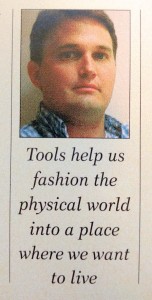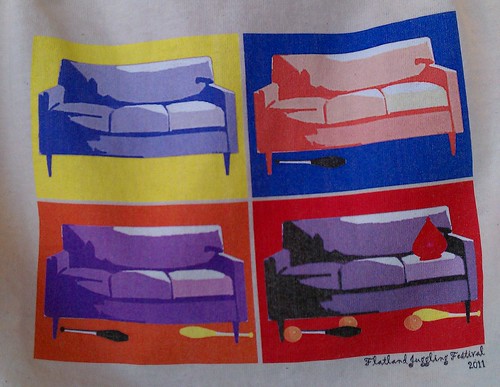When I’m not busy being funny onstage or working hard in my office, I like to make things in my workshop. Woodworking is my main activity, but I have skills in metal and other materials as well. If you’d like to stay informed on what I’m making, you can subscribe to my YouTube channel, and be sure to click the button to receive notifications… if you’re into that kind of thing.
Tue 1 May 2018
Subscribe to My Revitalized YouTube Channel
Posted by mark under General
Comments Off on Subscribe to My Revitalized YouTube Channel
Tue 22 Dec 2015
The Romance of Old Tools
Posted by mark under General
Comments Off on The Romance of Old Tools
I got tired of not being able to share this article with my friends around the world. I tore out and saved this one page from my Newsweek magazine in 1995. It was published just after I had taken my first woodworking class. The internet tells me that Newsweek plans to make their entire archive digital and available to the public, but since they haven’t gotten to it yet, I typed this article out so people can enjoy it now.
Mark
The Romance of Old Tools
Worn-In Jointers and Planes Manifest the Highest Aspirations of My Art
Newsweek magazine, My Turn section
September 18, 1995, by Chris Cernich
I HAD BEEN A PRACTICING WOODWORKER FOR MORE THAN seven years before I learned what tools were really about. Last year, back at my childhood home in Colorado, I visited an uncle I hadn’t seen for more than a decade. He was fighting the final stages of lung cancer; visits, though welcome, were physically demanding for him, so I took along my portfolio to show him what I had been up to in recent years – something that would not require much active effort from him.
A weekend woodworker long before he married into my father’s family, he was overjoyed to find that the gene had somehow jumped blood lines to another generation. He commandeered my portfolio and insisted that his son take me into the workshop to view the legacy he would soon be passing on to him: an old handbrace and some 30 aged wood-boring auger bits, all lovingly wrapped in an old cotton bundle.
These were the tools my uncle had inherited from his father, one of the first carpenters to settle in this Colorado community. Long ago, these tools had built much of this town. They were still used as recently as the previous summer, when my uncle and cousin built a new garage. For my uncle, these were among the most meaningful artifacts of his entire 80 years: they were the only direct connection my uncle had with his late father, and the most intimate communication my cousin would be able to maintain with either of them. When my cousin held the brace, he was holding his past, joining hands through time with his father and his grandfather.
I have never known a woodworker who didn’t have at least one antiquated or obsolete tool. I still use several hand planes and a brass fire extinguisher that are older than I am. Listening to my cousin’s reverent account of childhood walks through town to survey his grandfather’s workmanship, I began to understand why out-of-date tools so fascinate those of us who work with our hands, why they become cherished favorites even in shops overflowing with the latest technological innovations.
Tools help us fashion the physical world into a place where we want to live. With them, we create places that are warm and inviting. They give credence to the notion that the world serves us, shelters us, manifests our fears and displays our triumphs. The gods of the ancient world, endowed with powers over nature, were each identified with a specific tool – Neptune with the trident, Vulcan with the forge, Thor with the hammer; Jesus of Nazareth was a carpenter. Tools let us play at being gods. When we make the world conform to our ideas of how it should look or feel, we come very close to remaking the world in our own image.
A friend who teaches 17th-century British literature owns several tiny books printed during that era. They are the primary research tools of his field, but he has never used them as such. Instead, they are displayed atop a bookcase in his study – visible evidence that the period really did exist, and enduring reminders of a world to which he has dedicated his career. For much the same reason, another friend displays in his medical office a set of scientific manuals printed in 1886. He inherited them when he took over the practice of an older physician. They have little use short of showing procedures for applying leeches.
I took up woodworking when I entered graduate school because I couldn’t afford the furniture I wanted. I stayed with it through my dissertation on American literature because my efforts in the wood shop produced comparatively tangible results. Though most of the furniture I design today will outlast me, all of it will be assaulted by sunlight, fire, teething puppies, small children or adults too heavy for its joinery. But time and hard use will not diminish a tool. Old, worn, still-working tools manifest the highest aspirations of my art in ways that even the best of my creations cannot. I don’t think in these terms every time I pick up a chisel, of course. But I sense the significance, as can any visitor to my shop, in the character of my older tools, in the grip or thumbhold patiently worn to the exact fit of the craftsman’s hand. There is a tactile delight in shaving with a well-tuned plane. There is a deep resonance in shaving with one of my old planes, held by hands I’ve never known, used for the same reasons I use it now. And there is deeper resonance in tools whose use reanimates a past otherwise inaccessible.
When I left the cooperative shop where I first worked to open my own shop, my father sent me a six-inch Atlas jointer. He had bought it in the early ‘50s when, just back from the Geologic Survey in Alaska and flush with funds, he had set up his own rudimentary workshop in the chicken coop at his parents’ home. The jointer is too small for most of the work I do, and it rattles almost uncontrollably when it’s not under load. The noise, even at the smallest depth of cut, terrifies my dog.
I can now afford a bigger, better jointer, yet I remain loyal to this one. Every time I use it, I can relive that moment when, at 5 or 6 years old, exploring the dark jungle of bicycle parts and old bedsprings in the aging barn behind my parents’ house, I first came upon this rusting, incongruous hulk. It was my first brush with my profession; using this joiner now revives in me the sense of wonder with which I began.
One of my best planes is handmade from an African rosewood and holds a Japanese steel bimetal iron. At some point in the future it will be my son’s or daughter’s or nephew’s favorite heirloom; I can already tell, because it is so thoroughly invested with the oils of my hands and the aura of my work. But it is not my favorite, because it is still too new. It hasn’t seen what my old, anonymous metal planes have seen; it hasn’t had the impact on generations and lives that they’ve had. And it will need years to soak up as much personal and family and human history as my most recently acquired tool – the jointing plane my uncle pulled from his own collection and sent to me in the evening after my visit, a few hours before he died.
 CERNICH designs and builds custom furniture in Ann Arbor, Mich.
CERNICH designs and builds custom furniture in Ann Arbor, Mich.
Sat 13 Jun 2015
Beautiful video of a squid releasing young
Posted by mark under General
Comments Off on Beautiful video of a squid releasing young
Really gorgeous. Watch the whole thing if you can muster up the patience.
Fri 5 Jun 2015
Mark’s TEDx Talk Video Relased
Posted by mark under General
Comments Off on Mark’s TEDx Talk Video Relased
Mark was invited to speak at the very first TEDx in Lawrence KS.
Tue 29 Apr 2014
Need more Mark Hayward? Sign up for the newsletter!
Posted by mark under General
Comments Off on Need more Mark Hayward? Sign up for the newsletter!
If you’d like to get occasional updates about what I’m doing, sign up. If you don’t like it, you can always unsubscribe. It’s easy, and I won’t be mad.
Tue 4 Mar 2014
New Discoveries in the New Hebrides Deep Sea Trench
Posted by mark under General
Comments Off on New Discoveries in the New Hebrides Deep Sea Trench
The deep sea continues to be an amazing place full of surprises. A recent expedition to the New Hebrides deep-sea trench found an enexpected ecosystem and some awesome critters.
http://www.theverge.com/2014/3/4/5469016/new-hebrides-trench-explored-unexpected-eels-found
Tue 1 Jan 2013
MadFest Juggling Convention January 18-20
Posted by mark under General
Comments Off on MadFest Juggling Convention January 18-20
If you’re in the Midwest this January come join us at the MadFest Juggling Convention, and make sure to get tickets early for the Juggling Extravaganza at the Barrymore Theater on Saturday the 19th at 7:00pm. I’ll be the MC of the show, so that will be fun. Plus the great line-up of acts of course.

More info at www.madjugglers.com/madfest
Tue 20 Mar 2012
Stunt Lab Takes New York By Storm!
Posted by mark under General
Comments Off on Stunt Lab Takes New York By Storm!
 We’ve now finished our second sold-out weekend and gotten great reviews from the New York Times, The Villager, and Barista Kids.
We’ve now finished our second sold-out weekend and gotten great reviews from the New York Times, The Villager, and Barista Kids.
“Extremely Funny” – New York Times
“Dangerous, Amazing, and Wild” – The Villager
“We had such a great time that I’d shell out hard-earned cash to see it again.” - Barista Kids
There are only two weekends left for you to catch the show, and one show is already more than halfway sold, so don’t wait!
Mon 5 Mar 2012
Stunt Lab show to open in New York City
Posted by mark under General
Comments Off on Stunt Lab show to open in New York City
I’m creating a new show with my friend Jonathan Burns, called Stunt Lab, and it’s opening in New York City this Saturday. Yes, that’s right, I’ve finally made it to Off Off Broadway. Get all of your Stunt Lab info at www.markandjonathan.com

Sun 15 May 2011
Flatland Jugglefest Shirt
Posted by mark under General
Comments Off on Flatland Jugglefest Shirt
I was just at the Flatland juggling festival this weekend. It was way more fun than I expected, and I had pretty high expectations.
One of the highlights was the festival t-shirt. It is cool to begin with, but it has a giant top on it. I thought at first that it was my big top “Chubby” but then figured I was just being vain. Then I ran into the guy who made the shirt. He asked me “Did you see Chubby on the shirt?”
It actually IS my top on the shirt! That’s SO awesome. Now it’s my new favorite.


